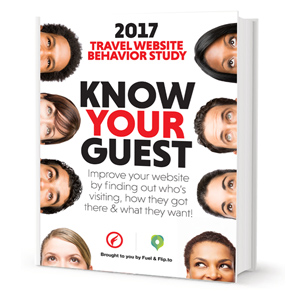How Hotels Can Adapt To A Dramatic 88% Drop In The Number Of Sites A Traveler Visits Before Booking
by Pete DiMaio
As shocking as it sounds, the latest research by TravelBoom and Flip.to shows that, on average, leisure travelers are only visiting 4.4 unique sites before booking. This is a massive decline from the past where research suggested upwards of 38 sites (based on a 2015 Expedia Media Solutions study).
This steep drop is one that hoteliers and travel marketers should pay special attention. The impacts on the planning process are clear, but the question becomes, “what can a hotelier do to ensure one of those 4.4 sites is their property site?” 
Before we answer that question, let’s look at possible causes for the drop in number of sites in just three short years:
- Consolidation: Where years ago customers would browse countless OTAs, portal sites, destination sites, and resort-specific sites, the times have changed. We have seen a consolidation in the planning space with fewer sites having a greater share in the traveler’s decision set.
- The Planning Cycle: Customers are beginning to expect instant gratification in their lives, in their loyalty programs, and yes – in their vacation planning. A shorter cycle between deciding to travel and actually traveling will result in fewer sites browsed during the process.
- Improved Sites: Now that the OTAs are offering reviews, TripAdvisor is acting more like an OTA, and individual hotel sites are more advanced; customers do not need to visit as many sites to get the information key to making a travel decision.
- Google Knows: Three years ago, search engines were no where close to where they are now in providing decision-making data on the SERP. With the improvements in the travel knowledge graphs, the adoption of Google Hotel Ads (GHA), and improved results in general, customers are finding the right information quicker than ever.
So now that we know possibly why the drop in sites visited has taken place, let’s dive into the key insights a hotel can glean from the data.
#1: Travelers Don’t Want to Search… But They Will.
We see a lot of travelers using between one and five sites to book. Then, it tapers off and soars again at 10+. This indicates that if you inspire travelers at the beginning, they won’t feel like they have to keep searching. If you don ‘t, it’s a miss – and off they go again searching.
#2: Search Visibility Is Key.
Given that most consumers only visit a small selection of websites, this underscores the importance of being visible in search so that your property does not get overlooked during the consideration phase.
#3: You Only Have One Shot To Impress; Don’t Blow It.
If you do get an opportunity to be one of the sites within the consumer’s selection set, make sure to have a website experience that delivers.
There’s More In the 2017 Travel Website Behavior Study
This is just a small portion of the research that was conducted by TravelBoom and Fip.to. We asked over 2,000 leisure travelers what pushes their buttons and converts them from site visitors to hotel guests.
